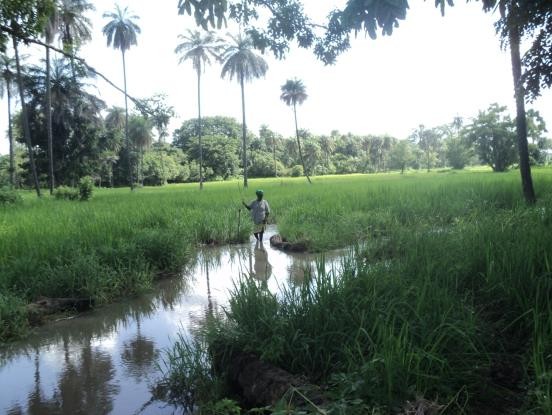
March 2015—The Sofaniama Djimara Valley is an important source of livelihoods for surrounding populations. The valley contains the only water source in the area and originates in The Gambia, creating a link between Gambian farmers and their Senegalese counterparts. This unfortunately results in conflicts over the management of the valley and its resources.
The river and valley are vital resources not only for the production of rice, fruits, vegetables and cereals, but also for herders and loggers. Deforestation in the neighboring Kolda region pushed the mainly agricultural population to seek new production zones in the valley, which also serve as stopping points for cattle herders.
This “gold rush” for the valley’s resources has resulted in tense relations and conflict between the competing stakeholders. “In this region, strategic use of each square meter can yield significant returns,” explained Kémo Traoré, a brick maker from the village of Medina.
USAID is helping the valley community come together and create a management system for its abundant resources. In 2012, more than 1,000 participants from 13 different community groups—more than 40 percent of whom were women—collaborated to develop the Sustainable and Coordinated Management Plan for the Sofaniama Valley.
The plan has an open, inclusive and empowering approach to engage people to anticipate sources of conflict and to put mechanisms in place to mitigate them. USAID promoted village-level dialogue to enable the communities themselves to drive local processes to head off disagreements.
“This is an important tool that allows us to manage conflict more effectively,” said Mamadou Ba, the subprefect of Niaming.
“We have all seen very quickly the benefits that this approach provides to the people who live around the valley,” added Missirah village chief Ousmane Kaïré. “By focusing on local dialogue and community decision making, we gained time to address other development issues important to our people.”
Rural councilor Ibrahima Baldé said the project has eased tension and conflict to such an extent that the communities have proposed rebuilding an old bridge between the two shores of the river, an apt metaphor under the circumstances and a literal way of improving social and economic exchange for the two sides.
The Governance and Peace Program in Senegal, which ended in 2014, was designed to support democracy, good governance and national reconciliation in the country. As part of the program, USAID mapped community-level conflicts that fuel the bigger conflict in this region of southern Senegal.
LINKS
Follow @usaidafrica, on Facebook, on Flickr, on YouTube







Comment
Make a general inquiry or suggest an improvement.